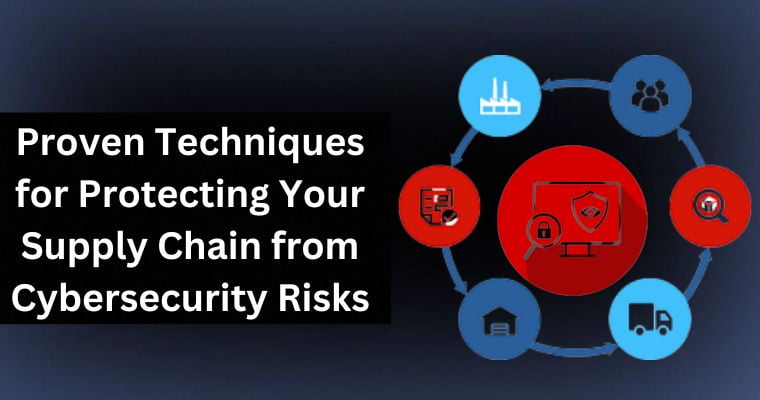Lazy, but cunning – that’s the nature of cybercriminals today. These hackers are consistently refining their tactics to maximize their impact with as little effort as possible.
The rise of Ransomware-as-a-Service is a prime example of how they’ve achieved such efficiency.
But perhaps the crowning achievement in cyberattack resourcefulness comes in the form of supply chain attacks.
These attacks have grown increasingly prevalent, even going so far as to cripple critical U.S. infrastructure. In response to this escalating threat, President Joe Biden has signed an ambitious
Executive Order aimed at completely overhauling supply chain cybersecurity standards for government entities and the private sector alike.
So, if you’re keen to bolster your supply chain against these attacks and stay ahead of the curve with the new Cybersecurity Executive Order, keep reading.
Table of Contents
What are Supply Chain Attacks and Why are They a Growing Concern?
Supply chain attacks are a type of cyber attack that targets the weakest link in a supply chain. This could be any vendor, manufacturer, or service provider involved in producing or delivering a product.
By exploiting vulnerabilities, attackers can infiltrate an organization’s network and compromise sensitive information, disrupt operations, or even cause physical damage.
The growing concern around supply chain attacks is due to the increasing complexity and interconnectedness of today’s supply chains.
With businesses relying on a vast network of suppliers and partners to meet their operational needs, the potential attack surface has expanded exponentially. This means that your supply chain could be at risk even if your own cybersecurity practices are top-notch.
Types of Supply Chain Attacks
There are several types of supply chain attacks, each posing unique challenges to businesses and their supply chains. We’ll delve into four key categories to give you a better understanding of the diverse landscape of these attacks.
Software Supply Chain Attacks
In a software supply chain security attack, cybercriminals exploit vulnerabilities in the software development process. They often do this by compromising a trusted software update or infiltrating the development environment.
This allows them to inject malicious code into widely-used software, which can then spread to any organization using that software.
Hardware Supply Chain Attacks
Hardware supply chain attacks involve tampering with the physical components of a product during its manufacturing or shipping process.
Attackers can embed malicious hardware or firmware into a device, which can later be used to compromise the security of the end user or even the entire supply chain.
Supplier Credential Compromise
In this type of attack, cybercriminals target the credentials of employees or contractors working within your supply chain partners. By gaining unauthorized access to these accounts, attackers can manipulate data, sabotage operations, or gain access to sensitive information.
Ensuring that all parties in the supply chain enforce strong password policies and utilize multi-factor authentication can help mitigate this risk.
Insider Threats
Insider threats originate from within your organization or your supply chain partners. These attacks can be perpetrated by disgruntled employees, contractors, or even spies infiltrating your supply chain.
They can involve theft of intellectual property, sabotage of operations, or other malicious activities that could negatively impact your business.
Implementing robust access controls, monitoring for unusual behavior, and conducting regular security awareness training can help protect against insider threats.
Understanding these different types of supply chain attacks can help you better assess your own risk and take appropriate precautions to protect your organization and its supply chain.
Risk Assessment and Vulnerability Management
Before you can start protecting your supply chains, you must assess your existing vulnerabilities and understand the potential risks you face.
This involves performing a comprehensive risk assessment that takes into account all of the suppliers, partners, and service providers in your supply chain.
Once you’ve identified potential weak points, you can develop a vulnerability management plan that outlines how you’ll mitigate and monitor these risks over time.
8 Proven Techniques for Protecting Your Supply Chain
Now that you have a better understanding of supply chain attacks, let’s learn how you can protect yourself during a cyber attack:
Conduct Due Diligence
Start by thoroughly vetting any new suppliers, partners, or service providers before entering into a business relationship with them. This includes reviewing their security policies, incident response plans, and compliance with relevant regulations.
By ensuring that they have robust cybersecurity practices in place, you can reduce the likelihood of an attacker infiltrating your supply chain through a vulnerable third party.
Create a Security-Focused Culture
Cybersecurity isn’t just the responsibility of your IT department; it’s something that everyone in your organization should be aware of and actively involved in.
By promoting a security-focused culture, you can help ensure that your employees understand the importance of protecting your supply chain and are more likely to follow best practices.
Tip 3: Encrypt and Secure Communications
To protect sensitive information exchanged between your organization and its supply chain partners, it’s essential to use encryption and secure communication channels.
This can help prevent attackers from intercepting and manipulating data as it’s transmitted between parties.
Utilize strong encryption methods, such as TLS (Transport Layer Security), to protect your data during transit, and consider implementing a secure file-sharing platform for sharing sensitive documents with your partners.
Regularly Monitor and Audit Your Supply Chain
Continuously monitoring your supply chain partners for signs of potential cybersecurity risks is crucial. Conduct regular audits to ensure that they are adhering to the agreed-upon security protocols and maintaining strong cybersecurity practices.
This will help you identify any areas of concern and take corrective action before an attacker can exploit a vulnerability.
Establish Incident Response Plans and Communication Protocols
In the event of a cybersecurity breach, having a well-prepared incident response plan can make all the difference in mitigating damage and getting your supply chain back on track.
Work with your partners to develop coordinated incident response plans and clear communication protocols so that you can respond effectively and swiftly to any potential threats.
Implement Robust Access Controls and Authentication
Limiting access to sensitive information and systems is a critical aspect of supply chain security. Implement strong authentication measures, such as multi-factor authentication (MFA), and enforce strict access controls for both internal employees and third-party partners.
Regularly review and update these controls to ensure that only authorized individuals have access to your supply chain’s critical systems.
Stay Informed about Emerging Threats and Best Practices
The cybersecurity landscape is constantly evolving, so it’s essential to stay informed about emerging threats and best practices for protecting your supply chain.
Subscribe to industry newsletters, attend conferences, and collaborate with industry peers to stay up-to-date on the latest trends and techniques in supply chain security.
Segmentation and Isolation of Critical Systems
One effective technique for protecting your supply chain is to segment and isolate critical systems within your organization and your supply chain partners.
By creating separate network zones and restricting access between them, you can limit the potential damage if an attacker does manage to infiltrate a part of the system.
This approach also makes it more challenging for an attacker to move laterally through your network, further reducing the risk of a widespread compromise.
Final Thoughts
Protecting your supply chain from cybersecurity risks is a complex and ongoing process. Luckily, by implementing these proven techniques, you can safeguard your organization and its valuable assets.
Remember, cybersecurity is a team effort, and fostering a security-focused culture within your organization is a critical component of maintaining a strong and resilient supply chain. Stay vigilant, stay informed, and stay secure.



